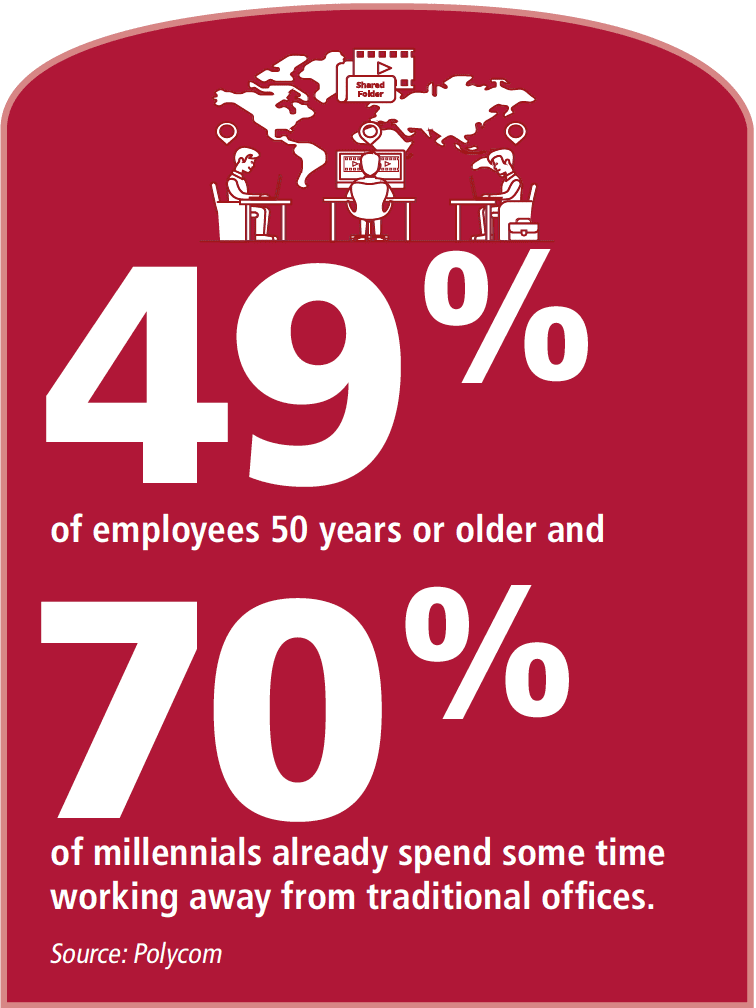Best practices for managing a remote workforce.
By Jo Deal
Remote work is no longer just for independent entrepreneurs, distant employees, or gig-economy workers. Smart companies are realizing they need to go where the talent is, even if that means hiring someone away from their offices. Remote work also does not exclusively refer to independent employees based away from a main office. It includes employees and teams who communicate and collaborate across multiple company offices -a reality that global organizations have embraced for a long time. Having this physical distance between teams requires companies to adapt and learn how best to manage and motivate when everyone is not in the same building.
With Polycom’s recent The Changing World of Work: A Global Survey reporting that 49 percent of employees 50 years or older and 70 percent of millennials already spend some time working away from traditional offices -and an ongoing uptick in these trends -HR leaders need to rethink their people programs and strategies to ensure high productivity and engagement.

Shifting away from the old school mindset of “what can’t be seen can’t be managed” is another key element of effectively overseeing a remote workforce. The person in the cube next to the manager may spend 10 hours a day in the office, but are they catching up on sports, shopping online, or planning their next vacation? Managers can’t assume that the employees they can see are working or that employees they can’t see aren’t. Therefore, managers need to set goals for each employee and have regular check-ins to compare goals with results. This allows managers to focus on each employee’s results and business impact, regardless of where they’re based.
If an employee’s results start to slip, managers need to explore why. Is it a skills or training issue, a poor hiring decision, or is there something else causing the employee to struggle? It’s not likely to be caused by working remotely. In fact, most people perform better in this setting as they can escape all the noises and distractions of the office.
How to Keep Remote Workers Engaged and Productive
According to a recent Gallup State of the Global Workforce Report, only 15 percent of employees globally are engaged at work. The lost productivity of the other 85 percent costs businesses an estimated $7 trillion per year. The message for HR managers is clear: Keeping employees engaged is essential for their productivity and the business’ success.
There is no question that managing remote workers can be challenging. Managers have to plan interactions and they can miss the rapport-building moments that naturally happen when in the office together.
However, with a little forethought, it is not difficult to create opportunities for engaging with remote employees. In addition to the individual performance check-ins, managers should coordinate regular virtual team meetings to help people stay connected with their remote teammates. These meetings are also a great opportunity for recognizing individuals’ accomplishments and for team building.
Additionally, managers should coordinate occasional in-person team activities that will further strengthen the bond between employees. One suggestion: Escape Room. A little competition goes a long way! During these in-person gatherings, managers should find ways to connect with remote employees on a personal level to strengthen relationships and make it more enjoyable to work together from a distance.
Active and regular communication is also key in continuing to grow the type of relationships typically built in person. Having access to a solid virtual collaboration platform will help make this communication seamless and effortless. The platform needs to be reliable, of course, but it should also work the way employees want it to work. This means offering a variety of options to collaborate, from real-time messaging and file sharing to audio and video conferencing. The ability to see colleagues, partners, and customers on video rather than just reading their messages or hearing their voice through a conference call helps employees connect with them on a more personal level. It also allows them to pick up on many subtle, nonverbal cues and guide the conversation accordingly. This is critical, as effective listening involves so much more than just hearing the words being spoken.
Video technology not only helps remote workers better understand what is said and not said, but it also keeps them more accountable; having the camera on encourages focusing rather than multitasking. Seeing the other people in a meeting makes it easier to stay engaged and retain the information being discussed.
Many companies enable remote working for its productivity benefits and others do so to attract the best talent out there. Whatever their motivation, companies shifting to a remote workforce need to change the way they measure performance, focus on keeping employees engaged, and ensure they have the right technology in place to support seamless collaboration.
Jo Deal is the CHRO of LogMeIn.













